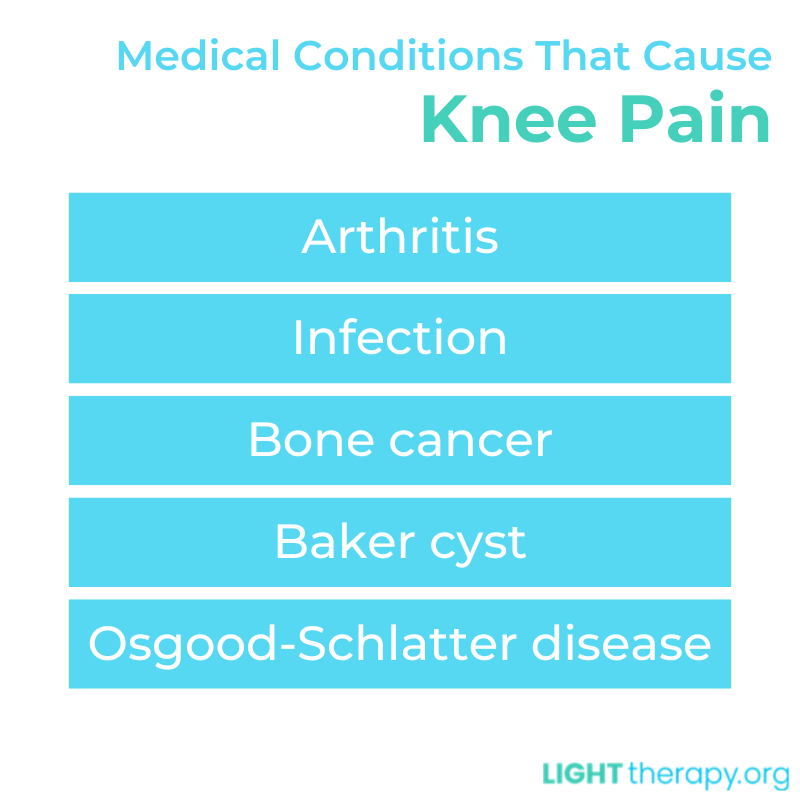Can Light Therapy Really Help Your Knee Pain?
Contrary to popular belief, happiness tends to increase later in life.
As people grow older, they learn more about what makes them happy, and they choose to spend their limited time focusing on the things that matter most to them: spending time with loved ones, giving back to the community, improving mental health, etc.
While that all sounds lovely, there’s a common issue with aging everyone agrees is no picnic — knee pain.
Anything from injury and disease to twisting your knee the wrong way can cause knee pain. As you search for treatment options, you may have come across information about red light therapy for knee pain.
But does light therapy for knee pain really work? The answer may depend on the cause of your discomfort.
What Is Light Therapy?
Before we consider red light therapy for knee pain specifically, let’s take a more general look at this treatment option and explore how it works to heal your body.
Light therapy uses various wavelengths of light — red and blue, most commonly — to energize cells. Each wavelength has a different effect on the body.
For example, when using red light therapy for knee pain, red wavelengths of light are applied directly to the knee. As the red light penetrates the skin, it energizes the cells, leading to improved blood circulation, reduced inflammation, and pain reduction.
How Does Red Light Therapy Heal?
Experts believe red light therapy energizes the mitochondria, the “powerhouses” of the cells. This energy boost then increases cell productivity, which in turn reduces pain and inflammation while promoting collagen production and wound healing.
Inflammation occurs as a side effect when the body’s immune system responds to a problem, such as an infection or injury. Symptoms of inflammation include swelling, redness, and tenderness. Swelling around a joint, like your knee, may cause pain and impair regular functions like bending, walking, or standing.
Since injury and inflammation often contribute to knee pain, red light therapy can be a good option for approaching treatment.

Causes of Knee Pain
Before we review recent clinical research into red light therapy for knee pain, let’s explore some common causes of this dilemma.
Injuries are the most frequent causes of knee pain. The pain associated with an injury can come from overuse, pressure, dislocation of the kneecap, a fracture or break in the bone, a torn ligament or torn cartilage, inflammation, improper posture, or a small strain of the ligaments from quick movements.
Alternatively, knee pain can result from an adverse medical condition, including iliotibial band syndrome (a type of tendon injury) or patellofemoral pain syndrome, which causes kneecap pain specifically.
The cause of neuropathic knee pain is nerve damage, usually from an injury. It presents as a shooting, tingling, burning, or stabbing feeling. You may also notice swelling of the joint, difficulty moving, tenderness, or even a popping sound.
Knee pain could also come from an underlying medical condition, such as:
- Arthritis
- Infection
- Bone cancer
- Baker cyst
- Osgood-Schlatter disease
If you suspect you may be suffering from an underlying health condition, schedule an appointment with your doctor to get a proper diagnosis.
What Does the Science Say About Light Therapy for Knee Pain?
Now that you’re armed with more information about knee pain and its causes, let’s explore what clinical research has to say about red light therapy for knee pain.
While red light therapy may not cure your injury or medical condition on its own, it can reduce the severity of your symptoms. This is especially true for symptoms related to injuries of the soft tissue around the knee, as well as conditions caused or exacerbated by inflammation.
As early as 1992, studies have shown that light therapy can relieve pain caused by degenerative osteoarthritis of the knee in elderly patients, leading to better functioning. A more recent study that tested light therapy on inflammation associated with osteoarthritis saw similar results.
Even more recently, a study published in “Arthoplasty Today” considered the healing power of light therapy on patients who received a total knee arthroplasty and found a significant reduction in post-operative pain and swelling.
Red Light Therapy for Knee Pain: Final Thoughts
As you consider red light therapy for knee pain, among other treatment options, remember that the knee joint is one of the largest, most complex joints in the body.
In addition to the four bones that make up the joint, it also includes a system of muscles and ligaments that work to create an optimal range of motion. Multiple treatment options may be necessary to fully heal that system.
Trouble within this complex system often results in pain, which can disrupt your daily functions. Thankfully, red light therapy can be an effective, risk-free way to manage knee pain, even if you require additional treatments for full healing.